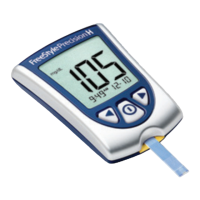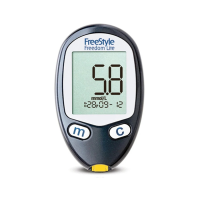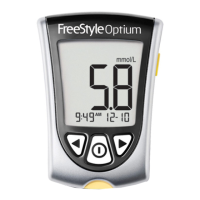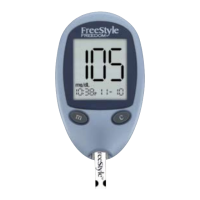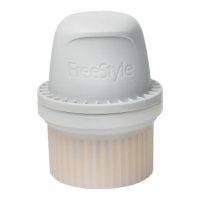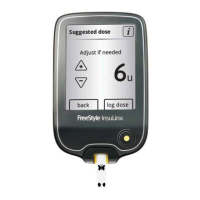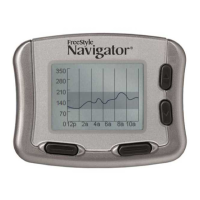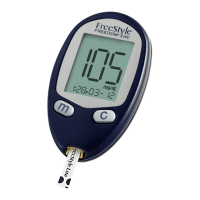Do you have a question about the Abbott FreeStyle Precision Neo and is the answer not in the manual?
Steps to set the meter's time, including selecting the format and adjusting hours and minutes.
Guidelines on when to perform a ketone test: during illness, high blood glucose, or as advised by a professional.
Steps for preparing the meter and site before a blood glucose or ketone test.
Instructions for inserting the test strip and initiating the blood glucose or ketone test.
Using the lancing device to obtain a blood sample.
Interpreting low blood glucose readings (solid/blinking red arrow, 'LO') and recommended actions.
Understanding normal and high blood ketone levels and factors influencing them.
Guidance on interpreting ketone results (0.6-1.5 mmol/L, >1.5 mmol/L, 'HI') and associated actions.
Steps for performing a control solution test, including inserting the strip and preparing the meter.
Instructions for cleaning the meter's exterior surfaces with a disinfectant wipe.
Procedure for disinfecting the meter using bleach wipes, ensuring wet contact for one minute.
Meaning of E-1 error (temperature too hot/cold) and steps to resolve it.
Meaning of E-2 error (general meter error) and steps to resolve it.
Meaning of E-3 error (small sample, incorrect procedure) and steps to resolve it.
Meaning of E-4 error (high glucose, strip problem) and recommended actions.
Meaning of E-5 error (sample applied too soon) and steps to resolve it.
Meaning of E-6 error (meter error) and steps to ensure correct strip usage.
Meaning of E-7 error (no coding, damaged strip) and steps to resolve it.
Meaning of E-9 error (meter error) and steps to resolve it.
Meaning of 'no response' error and steps to resolve meter issues like incorrect strip insertion or battery problems.
Meaning of 'test not starting' error and steps to resolve issues like insufficient sample or meter inactivity.
Steps to resolve meter issues such as incorrect strip insertion or battery problems.
Steps to resolve test initiation issues like insufficient sample or meter inactivity.
Steps to set the meter's time, including selecting the format and adjusting hours and minutes.
Guidelines on when to perform a ketone test: during illness, high blood glucose, or as advised by a professional.
Steps for preparing the meter and site before a blood glucose or ketone test.
Instructions for inserting the test strip and initiating the blood glucose or ketone test.
Using the lancing device to obtain a blood sample.
Interpreting low blood glucose readings (solid/blinking red arrow, 'LO') and recommended actions.
Understanding normal and high blood ketone levels and factors influencing them.
Guidance on interpreting ketone results (0.6-1.5 mmol/L, >1.5 mmol/L, 'HI') and associated actions.
Steps for performing a control solution test, including inserting the strip and preparing the meter.
Instructions for cleaning the meter's exterior surfaces with a disinfectant wipe.
Procedure for disinfecting the meter using bleach wipes, ensuring wet contact for one minute.
Meaning of E-1 error (temperature too hot/cold) and steps to resolve it.
Meaning of E-2 error (general meter error) and steps to resolve it.
Meaning of E-3 error (small sample, incorrect procedure) and steps to resolve it.
Meaning of E-4 error (high glucose, strip problem) and recommended actions.
Meaning of E-5 error (sample applied too soon) and steps to resolve it.
Meaning of E-6 error (meter error) and steps to ensure correct strip usage.
Meaning of E-7 error (no coding, damaged strip) and steps to resolve it.
Meaning of E-9 error (meter error) and steps to resolve it.
Meaning of 'no response' error and steps to resolve meter issues like incorrect strip insertion or battery problems.
Meaning of 'test not starting' error and steps to resolve issues like insufficient sample or meter inactivity.
Steps to resolve meter issues such as incorrect strip insertion or battery problems.
Steps to resolve test initiation issues like insufficient sample or meter inactivity.
| Display | LCD |
|---|---|
| Test Time | 5 seconds |
| Sample Size | 0.6 µL |
| Memory | 500 test results |
| Battery Type | 1 x CR2032 |
| Operating Conditions | 10 to 40 °C (50 to 104 °F), 10 to 90% RH |
| Storage Conditions | 10 to 90% RH |
| Measurement Range | 20 to 600 mg/dL |
